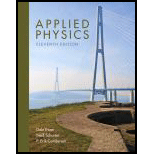
Applied Physics (11th Edition)
11th Edition
ISBN: 9780134159386
Author: Dale Ewen, Neill Schurter, Erik Gundersen
Publisher: PEARSON
expand_more
expand_more
format_list_bulleted
Concept explainers
Textbook Question
Chapter 24, Problem 2RQ
Which of the following did Albert Einstein not complete?
- a. General theory of relativity
- b.
Special theory of relativity - c. Principle of the warping of space-tine
- d. Grand unified Theory
Expert Solution & Answer
Want to see the full answer?
Check out a sample textbook solution
Students have asked these similar questions
Choose the BEST answer to the following:
What Einstein discovered about space and time is that they
(a) are separate entities.
(b) are parts of one whole.
(c) follow an inverse-square law.
(d) are special to space travelers.
State Einstein's principle of relativity. How does this principle then lead to his postulate that the speed of light is constant independent of the speed of the observer?
Which of the following is a CORRECT description of Einstein’s Geometric Theory of Relativity?
A. This theory supported Isaac Newton’s description of gravity as a spontaneous force of attraction between two objects with mass.
B. This theory implies that the gravitational force of attraction between two objects with mass does not come from gravity itself.
C. This theory describes that space and time are eleven-dimensional where each dimension has distinct characteristics and features.
D. This theory has two postulates similar to the Special Theory of Relativity that the laws of physics and speed of light are invariant.
Chapter 24 Solutions
Applied Physics (11th Edition)
Ch. 24.2 - If the tip of a pencil has a mass of 2.30 g, how...Ch. 24.2 - If a textbook has a mass of 1.30 kg, how much...Ch. 24.2 - How much mass is needed to create 600 J of energy?Ch. 24.2 - How much mass is needed to create 67.0 J of...Ch. 24 - What field or fields of physics intrigued Einstein...Ch. 24 - Which of the following did Albert Einstein not...Ch. 24 - Prob. 3RQCh. 24 - Prob. 4RQCh. 24 - If you are riding a bike at 10.0 m/s and throw a...Ch. 24 - Prob. 6RQ
Ch. 24 - According to Einsteins second postulate, if you...Ch. 24 - What does traveling close to the speed of light do...Ch. 24 - While you are sitting and reading this question,...Ch. 24 - Explain what E = mc2 represents.Ch. 24 - Prob. 11RQCh. 24 - Prob. 12RQCh. 24 - What happens to light and other electromagnetic...Ch. 24 - Explain how the solar eclipse of 1919 proved...Ch. 24 - A train is moving at a speed of 65.0 mi/h. The...Ch. 24 - How fast is the ticket collector in Problem 1...Ch. 24 - The ticket collector in Problem 1 turns around and...Ch. 24 - Convert the mass of one electron (m = 9.10 1031...Ch. 24 - Convert the mass of one proton (m = 1.67 10 27...Ch. 24 - A particular task requires 9 80 J of energy. Using...
Additional Science Textbook Solutions
Find more solutions based on key concepts
Using the information listed above, does Earth stay the same distance from the Sun throughout the year? If not,...
Lecture- Tutorials for Introductory Astronomy
B. Together with your classmates, take your ticker tape segments and arrange yourselves in a line, ranked accor...
Tutorials in Introductory Physics
2. Two very large charged parallel metal plates are 10.0 cm apart and produce a uniform electric field of 2.80 ...
College Physics (10th Edition)
A ball is batted upward at an angle. What happens to the vertical component of its velocity as it rises? With n...
Conceptual Integrated Science
A disk of radius R is suspended from a pivot somewhere between its center and edge (Fig. 13.35). For what pivot...
Essential University Physics: Volume 1 (3rd Edition)
60. The Gulf Stream off the east coast of the United States can flow at a rapid 3.6 m/s to the north. A ship in...
College Physics: A Strategic Approach (4th Edition)
Knowledge Booster
Learn more about
Need a deep-dive on the concept behind this application? Look no further. Learn more about this topic, physics and related others by exploring similar questions and additional content below.Similar questions
- Why did classical astronomers conclude that Earth had to be motionless?arrow_forwardCan classical physics be used to accurately describe a satellite moving at a speed of 7500 m/s? Explain why or why not.arrow_forwardTwo astronomical events are observed from Earth to occur at a time of 1 s apart and a distance separation of 1.5109m from each other. (a) Determine whether separation of the two events is space like or time like. (b) State what this implies about whether it is consistent with special relativity for one event to have caused the other?arrow_forward
- In a laboratory frame of reference, an observer notes that Newtons second law is valid. Assume forces and masses are measured to be the same in any reference frame for speeds small compared with the speed of light. (a) Show that Newtons second law is also valid for an observer moving at a constant speed, small compared with the speed of light, relative to the laboratory frame. (b) Show that Newtons second law is not valid in a reference frame moving past the laboratory frame with a constant acceleration.arrow_forwardIf you use an Earth based telescope to project a laser beam onto the moon, you can move the spot across the moon's surface at a velocity greater than the speed of light Does this violate modern relativity? (Note that light is being sent from the Earth to the moon, not across the surface of the moon.)arrow_forwardAstronomical observations of our Milky Way galaxy indicate that it has a mass of about 8.1011 solar masses. A star orbiting on the galaxy's periphery is about 6.0104 light years from its center. (a) What should the orbital period of that star be? (b) If its period is 6.0107 instead, what is the mass of the galaxy? Such calculations are used to imply the existence of "dark matter" in the universe and have indicated, for example, the existence of very massive black holes at the centers of some galaxies.arrow_forward
- Choose the BEST answer to the following: Einstein’s second postulate tells us that the speed of light (a) depends on one’s frame of reference. (b) is a constant in all frames of reference. (c) provides accurate clocks. (d) slows in a transparent medium.arrow_forwardSome people dismiss the validity of scientific theories by saying that they are “only” theories. The law of universal gravity is a theory. Does this mean that scientists still doubt its validity? Explain.arrow_forwardIdentify Einstein's two postulates for the Special Theory of Relativity and include evidence that supports them. Include a diagram and relevant physics terminology in your answer.arrow_forward
- Which of these would be a good frame of reference for describing motion using Newton's methods? Pick all that apply. What Newton termed an "inertial frame of reference", meaning in effect a frame that is not accelerating. All the universe. That is, an average of everything around us that is not part of the system we are studying. Any frame. It doesn't matter. The rotating Earth.arrow_forwardDifferentiate between Special Theory of Relativity and General Theory of Relativity. Broad explanation is needed.arrow_forward9, Which of the following achievements was been attributed to Isaac Newton: a. Laws of Motion. b. General Relativity. c. Quantum Mechanics. d. Geocentric Model for the Solar System.arrow_forward
arrow_back_ios
SEE MORE QUESTIONS
arrow_forward_ios
Recommended textbooks for you
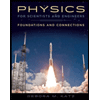 Physics for Scientists and Engineers: Foundations...PhysicsISBN:9781133939146Author:Katz, Debora M.Publisher:Cengage Learning
Physics for Scientists and Engineers: Foundations...PhysicsISBN:9781133939146Author:Katz, Debora M.Publisher:Cengage Learning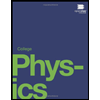 College PhysicsPhysicsISBN:9781938168000Author:Paul Peter Urone, Roger HinrichsPublisher:OpenStax College
College PhysicsPhysicsISBN:9781938168000Author:Paul Peter Urone, Roger HinrichsPublisher:OpenStax College AstronomyPhysicsISBN:9781938168284Author:Andrew Fraknoi; David Morrison; Sidney C. WolffPublisher:OpenStax
AstronomyPhysicsISBN:9781938168284Author:Andrew Fraknoi; David Morrison; Sidney C. WolffPublisher:OpenStax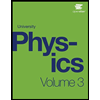 University Physics Volume 3PhysicsISBN:9781938168185Author:William Moebs, Jeff SannyPublisher:OpenStax
University Physics Volume 3PhysicsISBN:9781938168185Author:William Moebs, Jeff SannyPublisher:OpenStax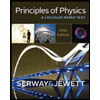 Principles of Physics: A Calculus-Based TextPhysicsISBN:9781133104261Author:Raymond A. Serway, John W. JewettPublisher:Cengage Learning
Principles of Physics: A Calculus-Based TextPhysicsISBN:9781133104261Author:Raymond A. Serway, John W. JewettPublisher:Cengage Learning Horizons: Exploring the Universe (MindTap Course ...PhysicsISBN:9781305960961Author:Michael A. Seeds, Dana BackmanPublisher:Cengage Learning
Horizons: Exploring the Universe (MindTap Course ...PhysicsISBN:9781305960961Author:Michael A. Seeds, Dana BackmanPublisher:Cengage Learning

Physics for Scientists and Engineers: Foundations...
Physics
ISBN:9781133939146
Author:Katz, Debora M.
Publisher:Cengage Learning

College Physics
Physics
ISBN:9781938168000
Author:Paul Peter Urone, Roger Hinrichs
Publisher:OpenStax College

Astronomy
Physics
ISBN:9781938168284
Author:Andrew Fraknoi; David Morrison; Sidney C. Wolff
Publisher:OpenStax

University Physics Volume 3
Physics
ISBN:9781938168185
Author:William Moebs, Jeff Sanny
Publisher:OpenStax

Principles of Physics: A Calculus-Based Text
Physics
ISBN:9781133104261
Author:Raymond A. Serway, John W. Jewett
Publisher:Cengage Learning

Horizons: Exploring the Universe (MindTap Course ...
Physics
ISBN:9781305960961
Author:Michael A. Seeds, Dana Backman
Publisher:Cengage Learning
General Relativity: The Curvature of Spacetime; Author: Professor Dave Explains;https://www.youtube.com/watch?v=R7V3koyL7Mc;License: Standard YouTube License, CC-BY